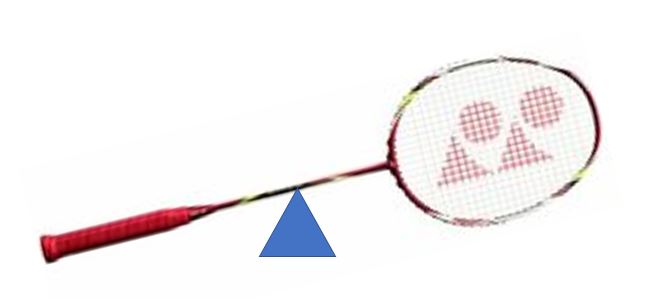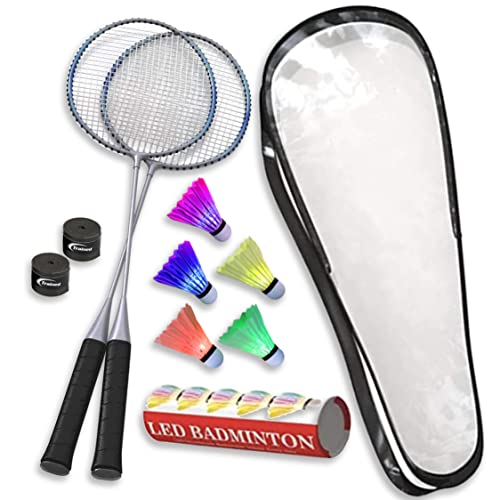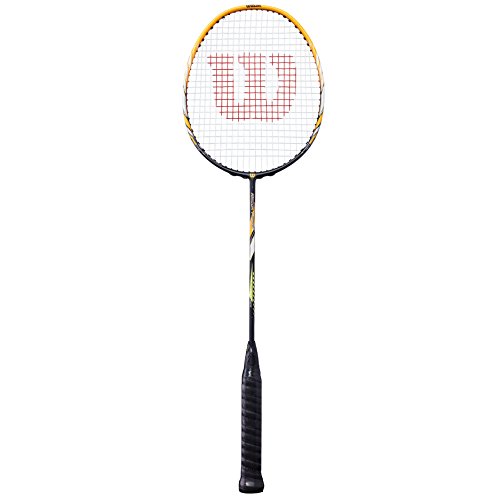Hey! This site is reader-supported and we earn commissions if you purchase products from retailers after clicking on a link from our site.
Choosing your first badminton racquet can be tough. That’s why I’m here to explain it to you! Come on a journey with me and let’s learn all about the best badminton racquets for beginners.
at a glance: our top 10 badminton rackets for beginners
Before I get started, I always like to give you by quick picks. These are all badminton racquets that I have personally played with and they offer a perfect mixture of traits for a beginner.
Best Beginner Badminton Rackets
Now, I’ve specifically chosen these 10 badminton racquets because I think they are the absolute best choices for a beginner. These racquets are cheap, user friendly, and absolutely perfect for people just learning the sport of badminton.
I’ve also provided slightly more expensive alternatives. These racquets are designed to grow with you as you learn.
#1 – Senston N80 Graphite High-Grade Badminton Racquet
The Senston N80 Graphite High-Grade Badminton Racquet is great for beginners.
Featuring an isometric, square-shaped head, the Senston N80 has a large sweet spot that makes hitting accurately that much easier for new players.
Additionally, the graphite and carbon fiber construction combined with the built-in T-joint provides excellent levels of durability and stability.
Thanks to the wooden handle, the Senston N80 also delivers a good amount of shock absorption to protect your arm.
However, the strings are pulled very tight, which may make them more likely to snap when hit hard.
Pros
- Isometric square head – Large sweet spot
- Built-in T-joint – Stable
- Graphite and carbon fiber – Highly durable
- Wooden handle – Good shock absorption
Cons
- Very tight strings – May be prone to snapping
#2 – YONEX Nanoray 10F Hi-Flex
The YONEX Nanoray 10F Hi-Flex badminton racket is often recommended to beginners, and we can see why!
If you look at the frame side-on, you’ll see that the top of the frame is thinner than the lower frame.
The thin upper frame reduces resistance and air drag, making for faster, cleaner swings. Meanwhile, the added thickness of the lower frame makes the entire frame more stable.
New to YONEX racket construction with this model is the carbon nanotube, which strengthens the overall frame and increases durability and impact resistance.
Like the Senston N80, the YONEX Nanoray 10F has a square, isometric head that extends the racket’s sweet spot in every direction, making it more difficult for beginners to miss.
The YONEX Nanoray, however, is slightly on the heavier side, so it does require some upper body strength to work with for long periods of time.
Pros
- Thin upper frame – Minimal resistance
- Thick lower frame – Enhanced stability
- Carbon nanotube – Increased durability
- Square isometric head – Broader sweet spot
Cons
- On the heavy side – Requires some strength
#3 – Dynamic Shuttle Sports Titan G-Force 7
The Titan G-Force 7 badminton racket by Dynamic Shuttle Sports was designed for advanced players, but it’s also ideal for players just starting out.
The frame is made entirely from graphite, which is both a lightweight and durable material. Both of these factors are essential in a badminton racket.
Something else that makes the Titan G-Force 7 a good choice for beginners is the medium-flex shaft, which provides the highest level of natural control with each swing.
Maintaining a firm grip on your racket is crucial for badminton, and the non-slip grip handle makes this possible.
Additionally, the racket comes with a protective cover, so the risk of damage between uses is less likely. However, some buyers have reported receiving damaged rackets due to insufficient packaging.
Pros
- 100% graphite – Lightweight and durable
- Medium-flex shaft – Optimal control
- Grip handle – Enables firm grasp
- Cover included – Protective
Cons
- Ineffective packaging – Some reports of damage during shipping
#4 – YONEX Nanoray Light 18i
The second YONEX badminton racket we’d like to share with you today is the Yonex Nanoray Light 18i.
This badminton racket has several similarities to the Nanoray 10F Hi-Flex, but also several key differences.
One similarity is the built-in T-joint, which makes for excellent frame stability. It also has the same isometric head which creates a wide sweet spot for greater ease of use.
The racket frame is made from carbon graphite, so it’s strong and impact-resistant while remaining lightweight.
Included with this badminton racket is a protective cover, so you can carry and store your racket safely between sessions.
The strings are strung relatively loosely, so you may need to have the racket restrung if this causes problems.
Pros
- Carbon-graphite construction – Strong and lightweight
- Built-in T-joint – Good frame stability
- Isometric frame – Wide sweet spot
- Includes cover – Reduced risk of damage
Cons
- Loose strings – May need to be restrung
#5 – Champion Sports Badminton Racket
The Champion Sports Badminton Racket is one of the top recommended badminton rackets for beginners.
Thanks to its steel frame, the Champion Sports racket is extremely durable. It’s resistant to most wear and tear and isn’t likely to break on impact.
The frame isn’t the only part of the racket that’s impact-resistant, however. The nylon strings are also highly durable and won’t snap easily.
We also approve of the dimpled leather grip on the handle, which enables a secure grip and better overall control of your swing.
Additionally, the price point for this badminton racket is very affordable, so it’s perfect for beginners that don’t have the budget for a more high-end racket.
The only downside is that because it has an oval head, the Champion Sports Badminton Racket has a smaller sweet spot which may make hitting accurately more challenging.
Pros
- Steel frame – Very durable
- Nylon strings – Impact-resistant
- Leather grip – Non-slip
- Affordably-priced – Budget-friendly
Cons
- Oval head – Small sweet spot
#6 – YONEX Arcsaber Lite
Another incredible beginners’ badminton racket from YONEX is the Arcsaber Lite.
The Arcsaber Lite comes in a pack of 2, which is great because it means you’ll always have a spare.
Featuring an isometric head, the YONEX Arcsaber Lite has a large sweet spot that makes it easy to hit the shuttlecock accurately.
The nanoair spring inside the frame also increases its flexibility, which will help you to put more power behind your shots.
A shuttlecock also comes included with the rackets, so you have everything you need to start playing!
However, the strings are relatively loosely strung, so you might want to look into getting some tighter strings if you find this affects the feel of your play.
Pros
- 2-pack – Includes a spare
- Isometric head – Enlarged sweet spot
- Nanoair spring – Increased power
- Shuttlecock included – Additional value for money
Cons
- Strung loosely – Restringing may be needed
#7 – Trained Premium Quality Badminton Rackets
These badminton rackets from Trained are a fun option for beginners to the game.
This is a pack of 2 badminton rackets that includes a set of LED shuttlecocks as well as a protective cover.
In addition to being protected between uses by the cover, the steel frames increase durability for maximum wear-resistance while giving the rackets a lightweight feel.
One potential downside of these rackets is the fact that they have oval heads, which makes hitting with the sweet spot more difficult than with isometric racket heads.
Thankfully, the included LED shuttlecocks make keeping your eye on the ‘ball’ that much easier, so you may find that the smaller racket heads aren’t too much of a hindrance to your performance after all.
Pros
- Steel frame – Lightweight and durable
- Pack of 2 – Good value
- Includes cover – Minimizes damage
- LED shuttlecocks included – Fun and useful
Cons
- Oval heads – Narrower sweet spot
#8 – YONEX Astrox FB
The YONEX Astrox FB has everything a new badminton player needs to perform at their best.
Thanks to the isometric head, the sweet spot of the racket is enlarged, which takes some of the difficulty out of hitting accurately.
Meanwhile, the carbon nanotube and nanomesh built into the construction of the racket ensures that the frame won’t break on impact.
The tri-voltage system also enhances the flexibility of the racket. This essentially maximizes the contact time between the shuttlecock and the racket, allowing for more transfer of power.
YONEX’s Astrox FB is counterbalanced for perfect weight distribution and maximum control. Unfortunately, the price point may be too high for some buyers.
Pros
- Isometric head – Maximized sweet spot
- Carbon nanotube and nanomesh – Impact-resistant
- Tri-voltage flex – Increases power
- Counterbalanced – Optimal weight distribution
Cons
- Expensive – Not budget-friendly
#9 – YONEX Muscle Power
Our final pick from YONEX is the Muscle Power badminton racket.
This racket has a graphite shaft and frame that is lightweight for faster swing speeds. It’s also impressively durable. Thanks to the built-in T-joint, the frame is very stable.
The strings are wound tightly into the racket head to enable greater durability (30 lbs of tension support). This makes the strings less likely to break during use.
YONEX has also provided a non-slip grip on the handle to help beginners achieve better control over the movements of the racket.
However, buyers should be aware that there have been previous reports of poor packaging leading to damage during shipping.
Pros
- Graphite frame – Lightweight and sturdy
- Tightly wound strings – 30 lbs tension support
- Built-in T-joint – Stable frame
- Non-slip grip – Allows for better control
Cons
- Poor packaging – Reports of damage during shipping
#10 – Wilson Recon
Last but not least, the Wilson Recon is a fantastic badminton racket for beginners.
The carbon fiber frame makes the Wilson Recon extremely durable and impact-resistant. Meanwhile, the non-slip grip around the handle not only maximizes your control over the racket, but helps to ensure that you don’t drop it, further enhancing its durability.
The Spider Silk technology used to construct this racket minimizes shock vibrations down the handle. This will help to protect your arm and improve the accuracy of your play.
Because this racket is head-heavy, it delivers naturally faster swing speeds, which can increase the power behind your shots. However, by the same token, the heaviness of the racket head might make the racket feel unbalanced or cumbersome.
Pros
- Carbon fiber frame – Highly durable
- Head-heavy – Faster swing speeds
- Spider Silk technology – Vibration control
- High-quality grip – Non-slip
Cons
- Not lightweight – Can feel cumbersome
Beginner Badminton Racquets: What You Need to Understand
Weight
Standard badminton racquets come in 3U (85-89g) or 4U(80-84g). These are common for every badminton brand out there and is the range from which you will most likely be choosing your racquet from.
Only in specialized cases, such as for a young child or a female player, will you want to stray outside of this weight range into 5U, or even F (70-74g) weights.
Generally, as a beginner, you will be looking for one in the 4U weight category. This provides a nice balance of ease of use, as well as enough weight to build some strength. While weight is an important factor, a 3U racquet can still feel light depending on the other two factors.
Grip Size
Grips nowadays come in G5 (81mm) or G4(84mm). I highly recommend getting a G5 grip size, solely because it is easier to build up a grip by adding more layers, than it is to shave down the wooden handle.
As you progress as get better, you will find yourself favoring a thinner grip. This is because as your technique advances and grows, you will use more finger and wrist strength, rather than relying on your shoulder and forearm.
Small grips allowing for more finger strength, while bigger grips, although more comfortable, do not allow for more advanced shots and will limit your play as you continue to grow.
My recommended configuration for a beginner is G5 with the factory grip and one 0.6mm over grip.
Balance
The balance of your racquet is its biggest defining characteristic. If a head light and head heavy racquet both have 3UG5 configurations for weight and grip, they will feel drastically different.
As a beginner, it is not as important to decide on what kind of balance you prefer now, but you will eventually find one that is right for you. Personally, I favored head light racquets when I was first starting.

As areas of my own technique improved, I found certain aspects lacking, so I switched to a heavier racquet and that is what I am using right now. For a good starting point, I would recommend getting an even balance (290-295mm) racquet.
Note: The way to find a racquets balance point is to put your finger in the middle of the shaft and balance it parallel to the ground. When you have found this point, measure it from the bottom of the racquet to that point, and you will have your balance point. (Another way is just to look at its specifications!)










Leave a Reply